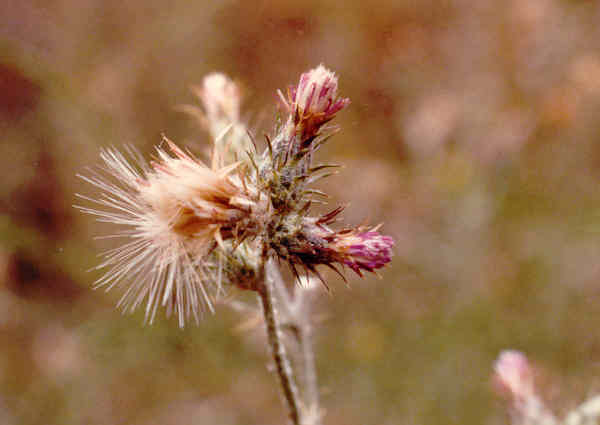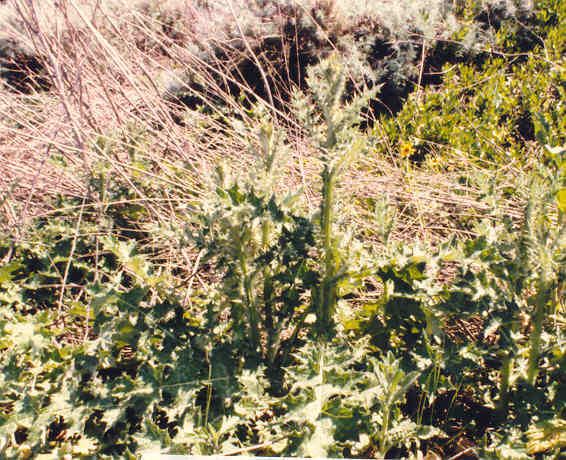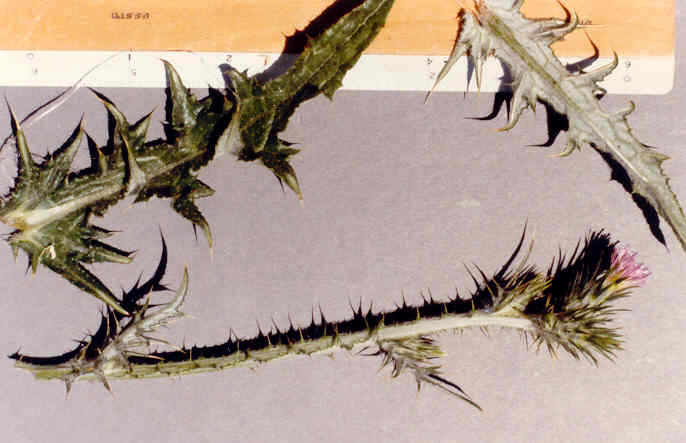
Carduus pycnocephalus L.
Asteraceae (Sunflower Family)
Europe
 |
Carduus pycnocephalus L.Asteraceae (Sunflower Family)Europe
Italian Thistle |
June Photo
Plant Characteristics:
Annual, 3-18 dm. high; the stems
slender, glabrous or slightly woolly, narrowly spiny-winged especially below;
lvs. pinnatifid, to ca. 12 cm. long, 4-10 lobed, the lobes and teeth
spine-tipped, white-tomentose beneath, green but +/- arachnoid above; heads 2-5
per cluster, sessile or short peduncled, sub-cylindric; phyllaries not
membranous-margined, +/- persistently floccose-tomentose, tips ascending;
corolla lobes ca. 3 times as long as the 5-8 mm. throat, rose purple; aks. light
tan or buff, ca. 20 nerved, 5-6 mm. long; pappus 15-20 mm. long, sordid.
Habitat:
Occasional weed along roadsides, waste places, etc.; below 1000 m.;
mostly to the north or our area. May-July.
Name:
Latin, carduus, a thistle.
(Jaeger 47). Greek, pychnos,
compact, dense and Greek, cephal, a
head. (Jaeger 50,214).
General:
This plant was uncommon when I first found it in 1986 along Back Bay Dr.
between Big Canyon and the its end at Eastbluff Dr. At this writing in 2005, it has become common around the
Upper Bay and very common in Big Canyon. I
considered trying to eradicate it along with Artichoke Thistle, Cynara
cardunculus when I was spraying it around the bay between 1996 and 2003 but
was told by the Fish & Game people, who were in charge at the time, not to
worry about it. In hindsight, I
should have sprayed it too. (my comments).
The larvae of the Painted Lady butterfly, Vanessa cardui, feed on
mallow, lupine, thistle and nettle. (No
author, sbnature, A Journal of the Santa Barbara Museum of Natural
History, Spring 2004/Vol. 2 No. 1, 6-8).
Large genus of Eurasia and n. Afr. (Munz,
Flora So. Calif. 133).
Text Ref:
Hickman, Ed. 220; Munz, Flora So.
Calif. 133; Roberts 9.
Photo Ref:
May-June 86 # 2,3,16,20; March-April 87 # 21,22.
Identity: by R. De Ruff.
First found: May 1986.
Computer Ref: Plant Data 303
Have plant specimen.
Last edit 10/14/04.
 |
 |
April Photo May Photo